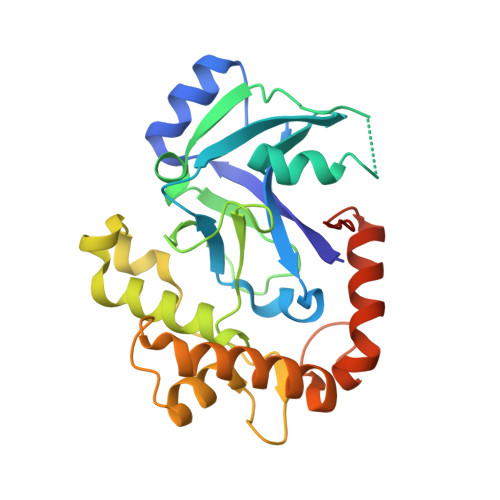Crystal Structures of the Human and Fungal Cytosolic Leucyl-tRNA Synthetase Editing Domains: A Structural Basis for the Rational Design of Antifungal Benzoxaboroles.
Seiradake, E., Mao, W., Hernandez, V., Baker, S.J., Plattner, J.J., Alley, M.R.K., Cusack, S.(2009) J Mol Biology 390: 196
- PubMed: 19426743
- DOI: https://doi.org/10.1016/j.jmb.2009.04.073
- Primary Citation of Related Structures:
2WFD, 2WFE, 2WFG - PubMed Abstract:
Leucyl-tRNA synthetase (LeuRS) specifically links leucine to the 3' end of tRNA(leu) isoacceptors. The overall accuracy of the two-step aminoacylation reaction is enhanced by an editing domain that hydrolyzes mischarged tRNAs, notably ile-tRNA(leu). We present crystal structures of the editing domain from two eukaryotic cytosolic LeuRS: human and fungal pathogen Candida albicans. In comparison with previous structures of the editing domain from bacterial and archeal kingdoms, these structures show that the LeuRS editing domain has a conserved structural core containing the active site for hydrolysis, with distinct bacterial, archeal, or eukaryotic specific peripheral insertions. It was recently shown that the benzoxaborole antifungal compound AN2690 (5-fluoro-1,3-dihydro-1-hydroxy-1,2-benzoxaborole) inhibits LeuRS by forming a covalent adduct with the 3' adenosine of tRNA(leu) at the editing site, thus locking the enzyme in an inactive conformation. To provide a structural basis for enhancing the specificity of these benzoxaborole antifungals, we determined the structure at 2.2 A resolution of the C. albicans editing domain in complex with a related compound, AN3018 (6-(ethylamino)-5-fluorobenzo[c][1,2]oxaborol-1(3H)-ol), using AMP as a surrogate for the 3' adenosine of tRNA(leu). The interactions between the AN3018-AMP adduct and C. albicans LeuRS are similar to those previously observed for bacterial LeuRS with the AN2690 adduct, with an additional hydrogen bond to the extra ethylamine group. However, compared to bacteria, eukaryotic cytosolic LeuRS editing domains contain an extra helix that closes over the active site, largely burying the adduct and providing additional direct and water-mediated contacts. Small differences between the human domain and the fungal domain could be exploited to enhance fungal specificity.
- European Molecular Biology Laboratory, Grenoble Outstation rue Jules Horowitz, France.
Organizational Affiliation:
















